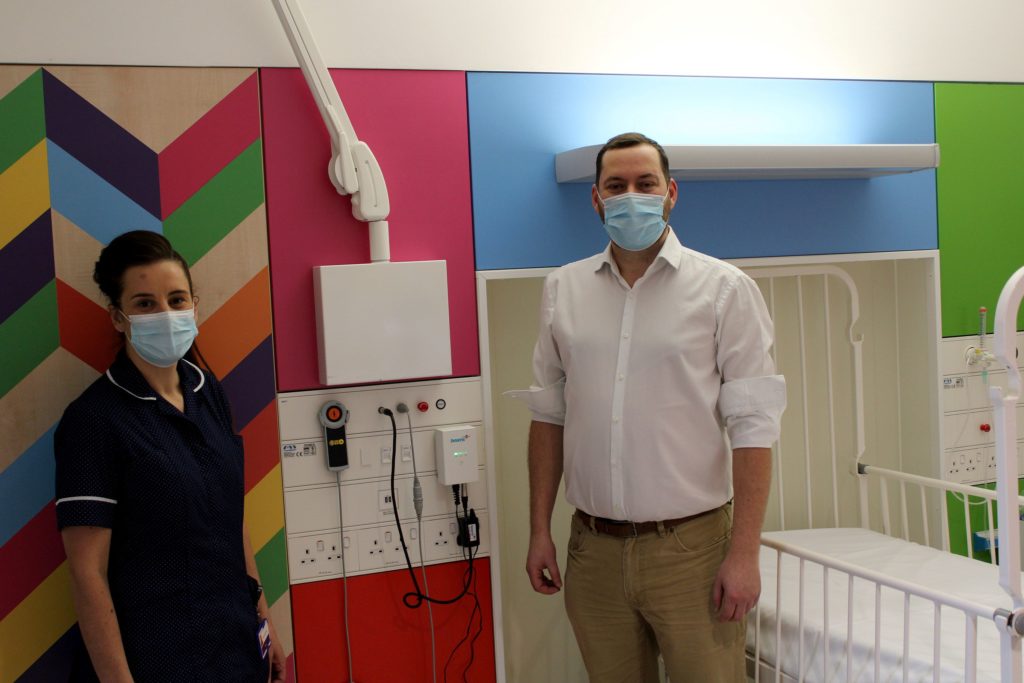BEAMS banishes alarm fatigue at Sheffield Children’s

Hospital Times recently travelled to Sheffield Children’s Hospital to find out about the benefits that BEAMS – the world’s first acoustic bedside equipment alarm monitoring system – has had on patient safety and staff workload.
Hospital staff are rightly keen to have all the tools at their disposal to be able to respond to urgent situations on wards and prioritise patient care effectively.
Bedside alarms are a case in point. They improve patient care, reduce stress for staff, and produce better outcomes for the wider health system. When Sheffield Children’s NHS Foundation Trust approached TBG Solutions in 2018, the trust was soon to be opening a new hospital wing, housing wards up to two times bigger than previously existed. The wing would also feature a higher percentage of single bedrooms than there were in the past.
While a boon to patient privacy and dignity, and better for infection control, the shift presented Sheffield Children’s then Medical Director, Professor Derek Burke, with a conundrum; how to preserve patient safety and ensure that alarms were heard and responded to when patients were behind closed doors?
Founded in 1876, Sheffield Children’s is one of only three stand-alone specialist children’s hospitals in the UK, primarily covering Sheffield and South Yorkshire but also offering specialist services to children from across the UK and internationally.
ICJ recently visited Sheffield Children’s to speak to the Matron for Medicine Care Group, Joanne Reid-Roberts, about the impact that BEAMS has had on nursing practice and patient safety in the new wing. We also asked Paul Rawlinson, Managing Director of TBG Solutions and sister company Tutum Medical, to speak to ICJ about the inception, design and roll-out of BEAMS, and about his vision for the future of BEAMS.
Why BEAMS?
Although not a medical device company, TBG Solutions is no stranger to highly complex technology, operating as a provider of testing, measurement, and control solutions to the aerospace, automotive, defence, medical and energy sectors. As such, they were well placed to take up Sheffield Children’s challenge, which Paul Rawlinson explains: “Most monitoring systems require central monitoring, and every piece of equipment needs to be plugged in to power and ethernet. If you’ve got eight or nine different pieces from different manufacturers, your only option is to have eight or nine central monitoring systems.
“Alternatively, you can go to a third party who will give you one interface, but you need to have the software library to mimic the instrument or touchscreen. If you need to add a new piece of equipment and there’s no software library from these third parties, then there is no interface. These solutions are also expensive,” adds Paul.
After a period of close consultation between Sheffield Children’s and TBG Solutions, the latter “concluded that for the best possible benefit to patient safety, you need a nurse in each room – which of course, you’re not going to get – but putting the ear of a nurse in the room is the next best thing.”

From this brief, BEAMS – and Tutum Medical – were born. BEAMS works by picking up and identifying tonal noises emitted by alarms, routing alerts to a central monitoring system through its own Wi-Fi mesh network – removing the need to interface with existing hospital infrastructure.
“Not only can it do this in an environment that might have a radio or TV on,” maintains Paul, “it can also identify what the equipment is doing. It could be a ventilator’s high priority alarm, and BEAMS can provide this detailed data. And so, if a nurse has four or five alarms going off, such as a ventilator alarm and an end-of-infusion alarm for an IV drip, they are able to prioritise which one to address first.”
Fewer alarms, safer patients
Following a clinical trial, designed to make it possible to compare alarm response times before and after the installation of BEAMS, the system was found to produce an 84 per cent reduction in the maximum alarm response time, and a 74 per cent average alarm response time. The system was subsequently installed into 70 single-occupancy rooms, and it has fast become a vital fixture for the Matron, Joanne Reid-Roberts.
Joanne tells Hospital Times that she “couldn’t imagine being on the wards without it”. She credits BEAMS with inducing a “calmer, and more relaxed atmosphere” on the wing, and helping to address the harmful consequences of alarm fatigue.
Studies have shown that in paediatric wards, up to 99 per cent of clinical alarms are either false or clinically insignificant (such as a battery needing to be changed) and do not warrant clinical intervention. Research also shows the consequences of this dynamic – alarm fatigue – which arises when alarms are so numerous (and often inconsequential) that they blend into the background and are missed.
BEAMS addresses alarm fatigue by helping to reduce the number of alarms sounding at any one time, relaying alarm information in a details spoken notification and making it more likely that any one will be picked up. The statistics appear to back this up; alarm response times at Sheffield Children’s have been cut by an average of 90 per cent, down to just 40 seconds.
“We wouldn’t be able to function without it.”
These efficiency savings add up, with only positive impacts on patient safety. “If a patient is on intravenous antibiotics,” Joanne illustrates, “BEAMS alerts us to say that the infusion has ended. If we missed that alert even for 30 minutes previously, what should have taken an hour would end up taking an hour and a half. It may sound small, but this can have a big impact on recovery.”
The second generation of BEAMS, currently in use at Sheffield Children’s and at Leeds Children’s Hospital, communicates the precise nature and severity of alarms, enabling the efficient delegation of tasks and saving precious clinical resource. It can now be instantly established whether an alarm requires the intervention of clinical staff or a support worker, “which has really improved the utilisation of our time,” Joanne adds.
Another important aspect of BEAMS is its reporting mechanism, which allows ward managers to see week-to-week reports detailing the number, location and nature of alarms, and response times, allowing them to pinpoint exactly where improvements are needed. Joanne is under no illusions that such comprehensive data reporting strengthened the impact of the BEAMS pilot, allowing them to demonstrate proof of concept and gain buy-in from the trust’s procurement and finance managers.
Importantly, and key for the workforce, Joanne is certain that BEAMS “has taken away many aspects of stress for staff. We no longer have to walk corridors just in case there is an alarm going off. It’s simple when you think about it, but we wouldn’t be able to function without it.”
Peace of mind for patients and carers
Having a loved one in hospital can be a troubling and anxious experience for anybody, not least when the patient is a child. In paediatrics, mere seconds can prove the difference between life and death – under certain conditions, children can reach an emergency condition faster than adults. This is often the case with respiratory conditions, where the smaller relative size of children’s airways can lead to greater difficulty with breathing than in adults.

While BEAMS has been successful in reducing average alarm response times, feedback from patients, parents and carers at Sheffield Children’s shows the reassuring effect it can also have. “It gives parents peace of mind,” Joanne relates. “It used to be normal that parents complained that alarms weren’t being addressed in a timely manner but that almost never happens anymore.”
She finds that most parents do not like to press the nurse call alarm for fear of wasting their time, yet are also fearful of what might happen if they are not at their child’s bedside. But, “BEAMS gives parents the confidence to know that the nurses will respond to their child’s needs if they are not there, and patients feel reassured because they know that somebody is coming,” a factor that can be important for recovery, explains Joanne.
Just the beginning for BEAMS
Joanne was full of praise for the manner in which Tutum Medical supported Sheffield Children’s throughout the trialling of BEAMS, recalling how easy it was to contact the company, and the fact that “they listened to our feedback and changed the product” according to the hospital’s need.
Why has BEAMS mostly been taken up in paediatric settings thus far? “It just so happened to be Sheffield Children’s who first wanted to trial BEAMS,” Paul says, “and Leeds like to look at what other children’s hospitals are doing.” Looking to the future, however, Paul hopes to see BEAMS deployed in other, non-paediatric settings (citing its particular utility for respiratory wards), and trials are indeed underway at a number of hospitals in England. According to Joanne, “there is no reason why BEAMS couldn’t go into adult services, as they will experience the same issues as us and will probably have less staff than we do.”
At Sheffield Children’s at least, the results are in; BEAMS is one of the tools that helps healthcare staff to provide the best possible care for their patients.
To find out more about BEAMS, visit www.tutummedical.com.
